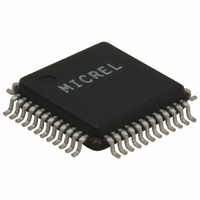KSZ8721CL TR Micrel Inc, KSZ8721CL TR Datasheet - Page 16

KSZ8721CL TR
Manufacturer Part Number
KSZ8721CL TR
Description
TXRX 10/100 3.3V 48-LQFP
Manufacturer
Micrel Inc
Type
Transceiverr
Datasheet
1.KSZ8721CL_TR.pdf
(33 pages)
Specifications of KSZ8721CL TR
Number Of Drivers/receivers
1/1
Protocol
MII
Voltage - Supply
3 V ~ 3.6 V
Mounting Type
Surface Mount
Package / Case
48-LQFP
Lead Free Status / RoHS Status
Lead free / RoHS Compliant
Other names
KSZ8721CLTR
KSZ8721CLTR
KSZ8721CLTR
KS8721CL
Power Management
The KS8721CL offers the following modes for power management:
100BT FX Mode
Please contact your local field application engineer (FAE) for a reference schematic on fiber connection.
100BT FX mode is activated when FXSD/FXEN is higher than 0.6V (this pin has a default pull down). Under this mode, the
auto-negotiation and auto-MDI-X features are disabled.
In fiber operation, the FXSD pin should connect to the signal detect (SD) output of the fiber module. The internal threshold of
FXSD is around 1/2 V
summarized in the following table:
To ensure proper operation, the swing of fiber module SD should cover the threshold variation. A resistive voltage divider is
recommended to adjust the SD voltage range.
FEF, repetition of a special pattern which consists of 84-one and 1-zero, is generated under “FX mode with no signal detected.”
The purpose of FEF is to notify the sender of a faulty link. When receiving an FEF, the LINK will go down to indicate a fault,
even with fiber signal detected. The transmitter is not affected by receiving an FEF and still sends out its normal transmit pattern
from MAC. FEF can be disabled by strapping pin 27 low. Refer to the “Strapping Options” section.
Media Converter Operation
The KS8721CL is capable of performing media conversion with two parts in a back-to-back RMII loop-back mode as indicated
in the diagram. Both parts are in RMII mode and with RMII BTB asserted (pins 21 and 22 strapped high). One part is operating
in TX mode and the other is operating in FX mode. Both parts can share a common 50MHz oscillator.
Under this operation, auto-negotiation on the TX side prohibits 10BASE-T link-up. Additional options can be implemented
under this operation. Disable the transmitter and set it at tri-state by controlling the high TXD2 pin. In order to do this, RXD2
and TXD2 pins need to be connected via inverter. When TXD2 pin is high in both the copper and fiber operation, it is disabled
transmit. Meanwhile, the RXD2 pin on the copper side serves as the energy detect and can indicate if a line signal is detected.
TXD3 should be tied low and RXD3 allowed to float. Please contact your Micrel FAE for a media converter reference design.
M9999-041405
FXSD/FXEN
Less than 0.6V
Less than 1.25V,
but greater than 0.6V
Greater than 1.25
• Power-Down Mode: This mode can be achieved by writing to Register 0.11 or pulling pin 30 PD# low.
• Power-Saving Mode: This mode can be disabled by writing to Register 1fh.10. The KS8721CL turns off everything
except for the Energy Detect and PLL circuits when the cable is not installed. In other words, the KS8721CL shuts
down most of the internal circuits to save power if there is no link. Power-saving mode is in the most effective state
when auto-negotiation mode is enabled.
DD
±50mV (1.25V ±0.05V). Above this level, the fiber signal is considered detected. The operation is
Condition
100TX mode
FX mode
No signal detected
FEF generated
FX mode
Signal detected
To the SD Pin of the
Fiber Module
Table 1. 100BT FX Mode
Rx +/-
Tx +/-
FTx
FR x
Figure 3. Fiber Module
Pin
KS8721CL
34
KS8721CL
(Fiber Mode)
Ref_CLK
Ref_CLK
16
21 22
21 22
TxC/
TxC/
Pin
Pin
RxD
TxD
TxD
RxD
V
V
CC
CC
50MHz
OSC
Micrel, Inc.
April 2005











